 |
|
 |
| |
发行人:林恭如所长 编辑委员:李翔杰教授 主编:林筱文 发行日期:2018.09.30 |
| |
|
 |
|
 本所曾雪峰教授获选为「教育部2018年度生命教育绩优人员」,特此恭贺!
本所曾雪峰教授获选为「教育部2018年度生命教育绩优人员」,特此恭贺!
 本所林本坚特聘研究讲座教授因持续扩展奈米级集成电路制造,荣获2018年「未来科学大奖」之「数学与计算器科学」奖项,特此恭贺! 本所林本坚特聘研究讲座教授因持续扩展奈米级集成电路制造,荣获2018年「未来科学大奖」之「数学与计算器科学」奖项,特此恭贺!
未来科学大奖目前设置「生命科学」、「物质科学」和「数学与计算器科学」三大奖项,单项奖金100万美元。要求其工作产生巨大国际影响,具有原创性、长期重要性或经过时间考验,并主要在大中华地区完成。
相关报导网页连结:
http://www.futureprize.org/
https://udn.com/news/story/7240/3356731
|
|
 |
|
 |
|
| |
|
 |
|
~ 2018 暑期大学生光电营 花絮报导 ~
(时间:2018年8月16日至17日;地点:台湾大学博理馆
)
花絮整理:所学会会长郭胜文
每年暑假,光电所会邀请各大学的学弟妹参加光电营的活动,今年也不例外。学弟妹来自四面八方,有的家就在台北,也有人住屏东为了来参加光电营而北上,令我们惊喜万分,谢谢你们愿意花暑假放假的时间来报名参加我们的营队。
活动一开始时,我们将学弟妹分组,约6至8人为一组,接着我们利用一些时间认识彼此,了解他们为什么会想来参加这个营队,大部分的回答皆是想来看看光电所都在做些什么或是暑假不知道要做什么,而特别让我们感到惊喜的回答则是未来想来台大光电所就读。我们也介绍自己,包含平常的生活和实验的部分。
|
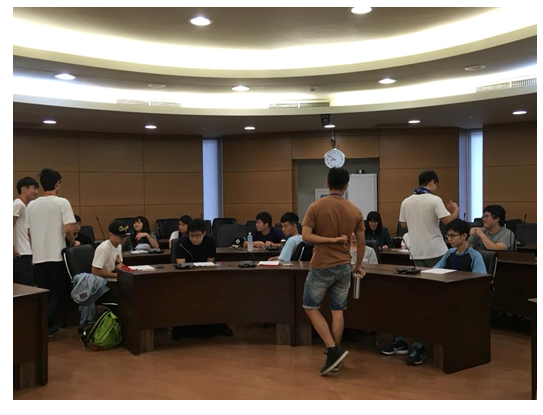 |
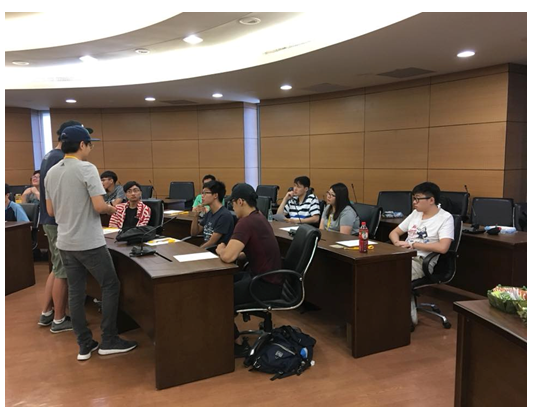 |
|
图一、队员与队辅互动 |
图二、队员与队辅互动 |
之后为了了解彼此与增进队员感情,我们准备名为「光电知识王」的活动让他们透过竞赛来互动,并且累积积分,最后积分多的可以获得光电所准备的精美礼物,利用这个活动可以让我们更了解小队员的个性,每位队员都为了自己队上的荣耀而努力着。
|
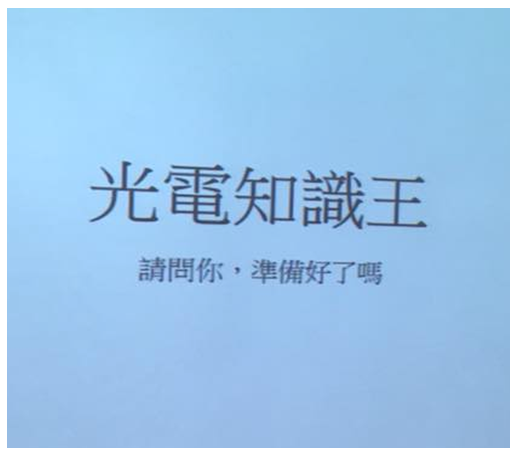 |
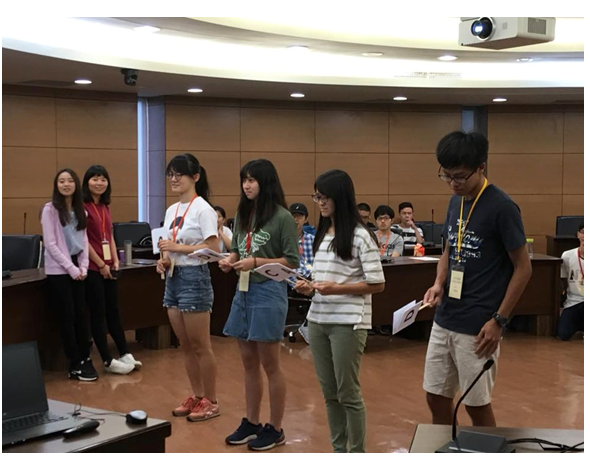 |
|
图三、光电知识王投影封面 |
图四、光电知识王实战情形 |
|
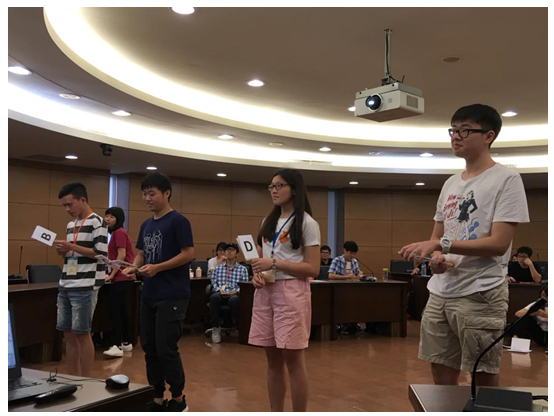 |
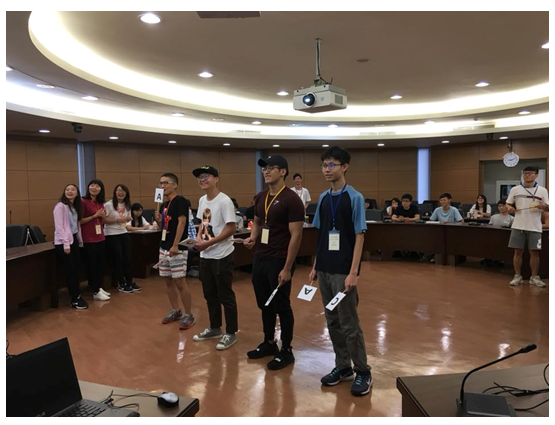 |
|
图五、光电知识王实战情形 |
图六、光电知识王实战情形 |
接着是课程的部分,我们请到所上教授或是博士班学长来替我们讲授一些关于光电的知识,透过专业的报告介绍关于光电的知识与分享光电产业的发展,每位学弟妹都听得很专注,从教授或是学长的分享中获得专业知识,也许学弟妹不是立刻都能融会贯通,但或多或少从中得到一些前辈们的经验,可以对未来预先规划,收获一定能让学弟妹不虚此行。
|
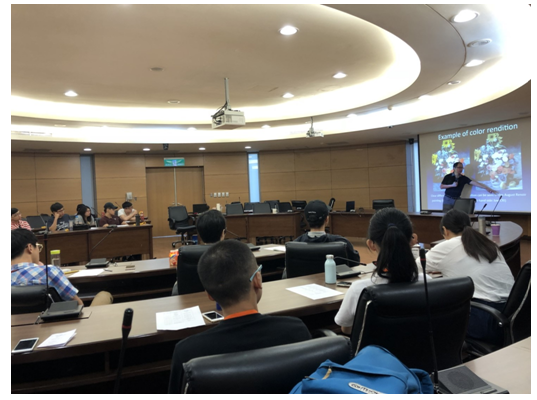 |
 |
|
图七、课程讲授(授课教师黄建璋教授) |
图八、认真听课的学弟妹 |
课程中我们还有参观无尘室与E-Beam实验室的安排,虽然无法让大家动手操作,不过我们藉由介绍的方式和亲眼目睹仪器,让大家有深刻的印象及初步了解,当中非常谢谢无尘室的厂务翁菲萍小姐和管杰雄老师实验室的帮助。
|
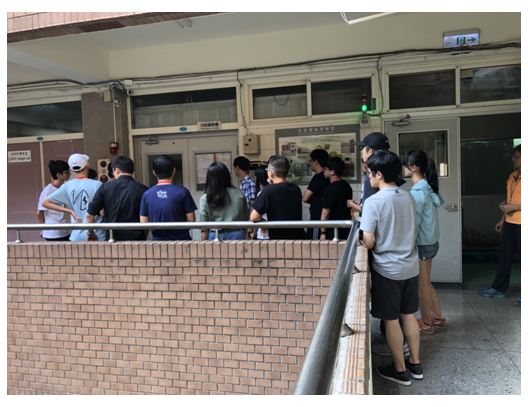 |
 |
|
图九、参观无尘室 |
图十、参观E-Beam实验室 |
最后是颁发证书的时刻,很感谢全程参与的学弟妹,让光电所举办的活动变得值得,当拿到证书时每个人的脸上都充满了笑容,相信你们对于这次的营队都感到开心且满足,不只是初步了解光电所、光电知识,最重要的是你们已经开始在规划自己的未来了。虽然只有短短的两天,经过短暂的相遇,我们期待着你们未来的大放异彩。这次活动非常感谢所办与所上的教授同学,也很谢谢所学会的伙伴,谢谢大家。
|
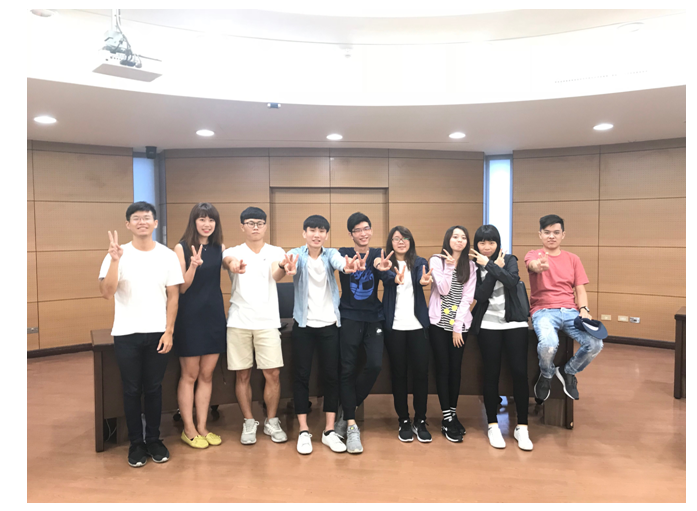
|
|
图十一、所学会的伙伴 |
|
|
|
|
|
 |
|
 |
|
| |
|
 |
Investigation of Streptavidin-Ligand Biochemical Interactions by IGZO Thin Film Transistors Integrated with Microfluidic Channels
Professor Jian-Jang Huang's laboratory
Graduate Institute of Photonics and
Optoelectronics, National Taiwan University
台湾大学光电所 黄建璋教授
This is a joint research work between Prof. Y.-H. Lo from UCSD and Prof. J.-J. Huang from GIPO NTU. In this work, we demonstrate an IGZO TFT-based biosensor integrated with a microfluidic channel to monitor biochemical reactions between proteins and small molecules. The target biomaterials are applied to a Y-shaped microfluidic chamber while the reactant signal is readout by the TFT. Using Biotin-Streptavidin reaction as an example, the specific diffusion time of biotin, streptavidin, or streptavidin-biotin complex across the fluidic channel are benchmarked. By intentionally delaying the application of one specie to another, one can study properties of biochemical reactions, such as excess and exhaust conditions of the reactants, and the formation of the products while diffusing in the channel. The proposed TFT sensor provides an excellent platform in understanding the biochemical functions for the advance of biological science and drug discovery.
Ref: This work was published in “Sensors and Actuators B: Chemical. 262. 10.1016/j.snb.2018.01.177”
|

|
|
Figure 1. (a) The cross section of the IGZO-TFT (b) Schematic diagram of a reusable TFT biosensor. The TFT and microfluidic channel were fabricated separately and then connected together by a bond wire. The cross linkers were applied on the surface of ROI. |
|
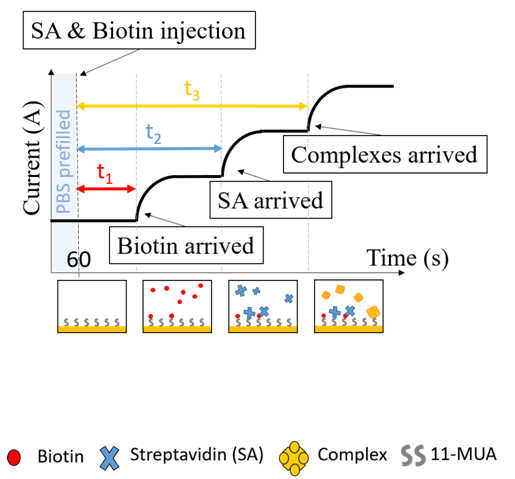
|
|
Figure 2. Scenarios of drain current responses when the biotin and streptavidin are applied to the fluidic channel. Using the transient response of drain currents, our system is able to detect the complete and incomplete bioreactions. The control measurement was also conducted to verify the reaction between ligands and proteins. |
High-Performance Vertically-Stacked Complementary Inverter Composed of Oxide Thin-Film Transistors
Professor I-Chun Cheng
Graduate Institute of Photonics and
Optoelectronics, National Taiwan University
台湾大学光电所 陈奕君教授
Complementary thin-film transistor (TFT) inverters are the fundamental building blocks for versatile thin-film logic circuits. They possess several desirable features, such as low static power consumption and high density circuit integration. Complementary inverters implemented in a vertically-stacked structure offer an additional advantage, small footprint, in comparison with their coplanar counterparts. Oxide semiconductors are promising candidate channel materials for TFT applications because they have relatively high carrier mobilities and can be processed at low temperatures. In this research, we report an on-glass high-performance vertically-stacked complementary inverter based on oxide TFTs. It is composed of a bottom-gate n-type ZnO TFT stacking on a top-gate p-type SnO TFT. Both active layers were deposited by a low-temperature rf-sputtering technique. Fig. 1 shows the transfer and output characteristics of both the ZnO and SnO TFTs. The ZnO TFT exhibits a threshold voltage of 5.1 V, field-effect mobility of 2.5 cm2/V-s, subthreshold swing of 1.8 V/decade, and on/off current ratio of 2.4х107. The corresponding values for the SnO TFT are 6.2 V, 0.35 cm2/V-s, 0.9 V/decade, and 2.2х104. Fig. 2 shows the static voltage transfer characteristics and gain curves of the vertically-stacked complementary oxide-TFT-based inverter with a geometric aspect ratio of 5 at supplied voltages ranging from 2 to 10 V. A high voltage gain of 56 V/V at a supply voltage of 10 V is achieved. The result demonstrates the feasibility of realizing oxide-TFT based complementary circuits with high-density integration.
|
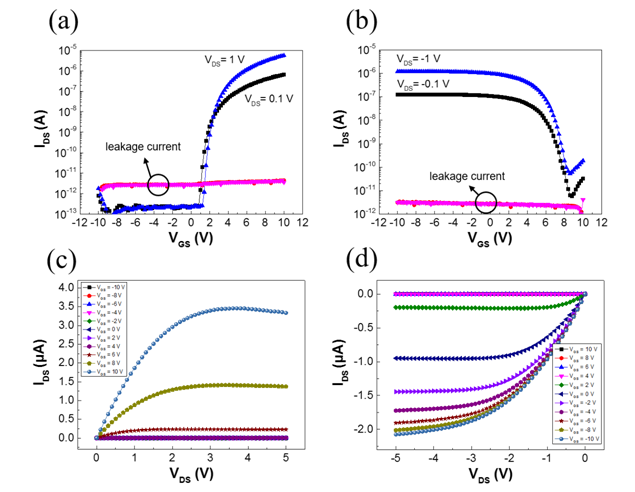
|
|
Fig. 1 (a)(b) Transfer and (c)(d) output characteristics of the bottom-gate n-channel ZnO TFT and top-gate p-channel SnO TFT. The channel dimensions are W/L = 40 μm/ 20 μm. |
|
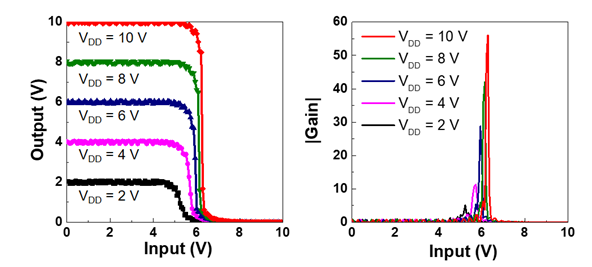
|
|
Fig. 2 (a) Static voltage transfer characteristics and (b) gain curves of the vertically-stacked complementary TFT inverter with a geometric aspect ratio of 5 at supply voltages ranging from 2 V to 10 V. |
|
 |
| |
|
|
|
 |
|
| |
|
 |
论文题目:以水溶液掺杂法制备超低接触电阻石墨烯场效晶体管
姓名:黄国佑 指导教授:吴志毅教授
| 摘要 |
|
接触电阻对于石墨烯(graphene)组件的效能具有关键性的影响,本研究使用了一种无须高分子辅助的转印手法,以确保石墨烯样品表面完全清洁,进而降低石墨烯与金属电极间之接触电阻以及提升组件效能,并且搭配使用真空退火(vacuum annealing)以及水溶液高分子掺杂改良石墨烯组件与金属电极之接触特性。进一步发现,使用HAT-CN聚合物掺杂过后之石墨烯,其功函数具有大幅度提升并形成P型石墨烯(机制如图一所示)。其接触电阻可大幅降低至36 Ω•µm,而在经过低温热退火后则可降低至24 Ω•µm。本实验以改良后之超低接触电阻石墨烯场效晶体管(Graphene Field-Effect transistors; GFETs)进行电性量测后,可发现组件之载子迁移率具有大幅度的提升,搭配ODTS自组装层(Self-Assemble
Monolayer; SAM)所修饰过之基板后便可得到电洞迁移率约为14400 cm2
V−1 s−1之石墨烯晶体管。而经由水溶液P型掺杂修饰过之石墨烯虽然会因为库伦散射之原因使其载子迁移率下降,但由于可大幅大改善石墨烯与金属间之接触电阻,因此载子迁移率亦可达到约5173
cm2 V−1 s−1
,(如图二所示)仍旧是非常具有竞争力之效能。本研究设计了降低石墨烯与金属电极间之接触电阻之结构与方法,除了提升石墨烯应用于各式组件之价值外,更可进一步搭配其它二维材料,使得二维材料的研究与应用能够更广更全面,对于科学以及工业界的发展可以带来更进一步的帮助。
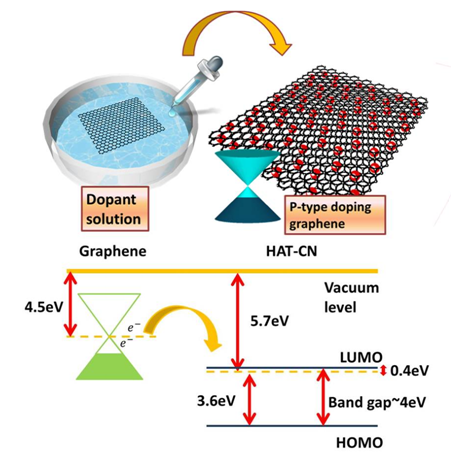 |
|
图一、水溶液掺杂示意图及HAT-CN掺杂机制 |
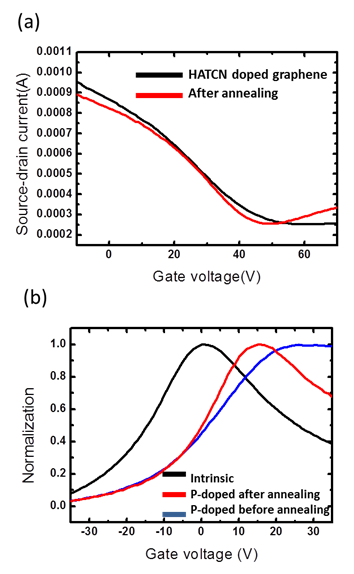 |
|
图二、(a) 掺杂HAT-CN后之石墨烯场效晶体管IV曲线 (b) 本质与掺杂后晶体管之电性曲线比较可发现狄拉克点(Dirac point)有明显位移 |
|
|
|
 |
|
 |
|
| |
|
 |
— 资料提供:影像显示科技知识平台 (DTKP, Display Technology
Knowledge Platform) —
—
整理:林晃岩教授、孟庆棠 —
纸上电子
以激光为基础的制造方式可支持从大型汽车零件到微小生医支架的各种组件的制造。现在,来自美国和中国大陆的科学家的研究展示,激光可以帮助实现3D可折迭式的纸上电子,如图一所示。来自加州大学柏克莱分校、清华柏克莱深圳研究所和美国陆军红石兵工厂研究中心的Xining Zang和同事开发了一种直写式激光造型程序,其可在纸上产生导电性碳化钼-石墨烯(MCG)区域(Adv.Mater.
https://doi.org/10.1002/adma.201800062; 2018)。
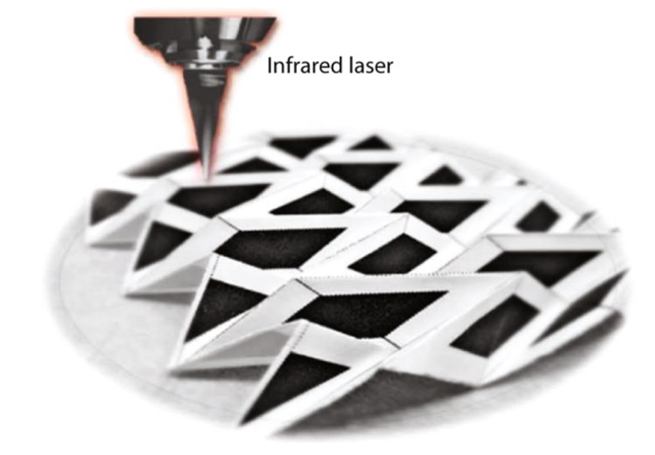 |
|
图一、在纸基板上(白色区域)利用激光直接写入MCG造型程序(黑色区域)之后,所制造折纸结构的光学照片 |
激光写入可以在有环境光的条件下进行。首先将含有Mo5+离子的凝胶油墨喷洒于纸上,然后利用10.6-μm CO2激光的光束以所需的造型扫描于纸上,用以产生可用作电极或电信道的黑色导电区域。写入激光的功率为2W;写入速度为200mm s–1。样品的拉曼与X光绕射结果显示了激光写入后Mo3C2与石墨烯的存在。激光照射区域的薄层电阻为每平方51.3Ω,此低于使用水溶性聚合物,其代替凝胶时所获得的薄层电阻。有趣的是,较厚的纸可以吸收和保持更多的墨水,因此可以在激光写入后得到较低的薄层电阻。
商业性复印纸具有良好的机械性强度和较低的薄层电阻。测试结果表示,纸上的MCG区域对于重复180°折迭性操作具有弹性。前50次折迭性操作通常导致电导率降低13%,但在随后的750次循环中电导率维持小于5%的衰减,如图二所示。此团队预见导电纸无数潜在的应用,其包括电化学离子侦测器和气体传感器、3D压电发电机和超级电容器电极。
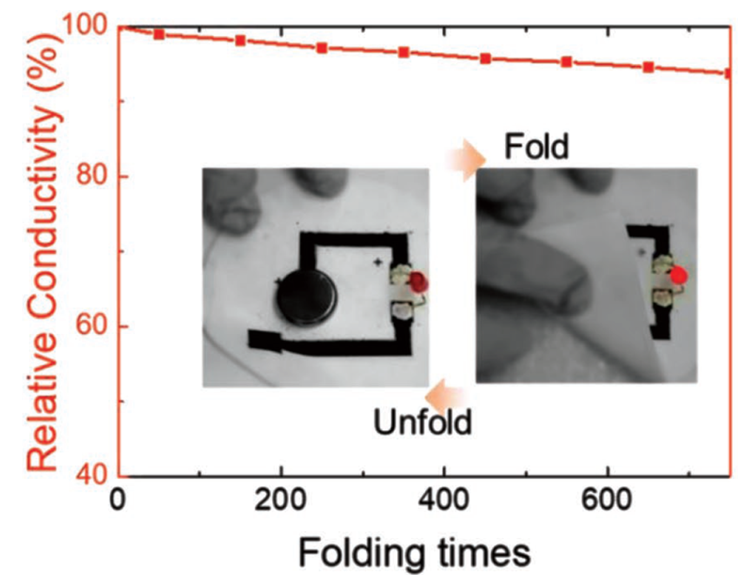 |
|
图二、记录180°机械式折迭试验的750次循环中,由MCG复合材料所制成的电性连接器的相对电导率。其中插图为使用机械式折迭和接触由MCG复合材料所制成的电极作为电性开关来开启或关闭红色发光二极管
。 |
|
参考资料: |
[1] Noriaki Horiuchi, “Paper electronics,”
Nature Photonics 12, 381 (2018)
https://www.nature.com/articles/s41566-018-0206-4
DOI: 10.1038/s41566-018-0206-4
[2] Xining Zang,* Caiwei Shen, Yao Chu, Buxuan Li, Minsong Wei, Junwen Zhong,
Mohan Sanghadasa, and Liwei Lin*, “Laser-Induced Molybdenum Carbide–Graphene Composites for 3D Foldable Paper Electronics,”
Adv. Mater., 30, 1800062 (2018)
https://onlinelibrary.wiley.com/doi/abs/10.1002/adma.201800062
DOI: 10.1002/adma.201800062
|
| |
|
|
|
|
|
|
|
|
|
 |
|
 |
|
|
|
 |
|
 |
|